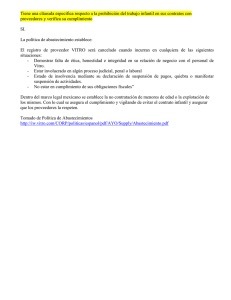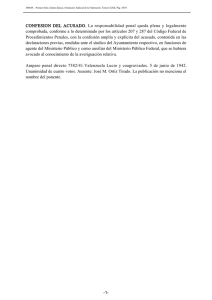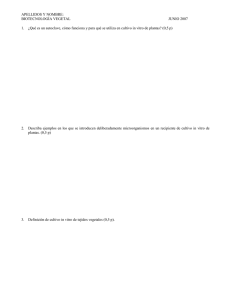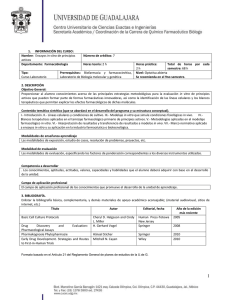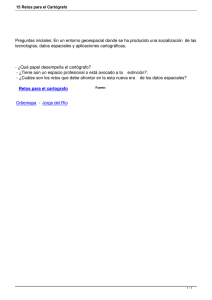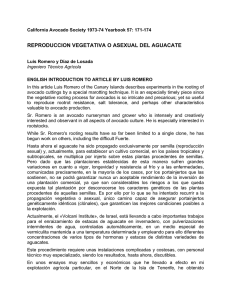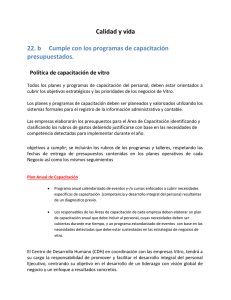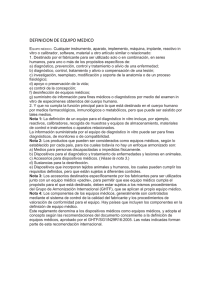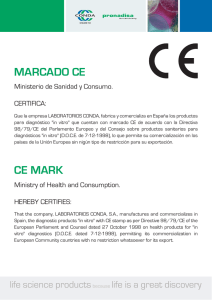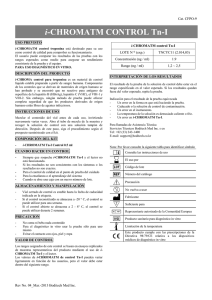wac6-MICROPROPAGATION AND IN VITRO RESISTANCE TESTS AGAINST Phytophthora cinnamomi OF MEXICAN-RACE AVOCADO GENOTYPES
Anuncio
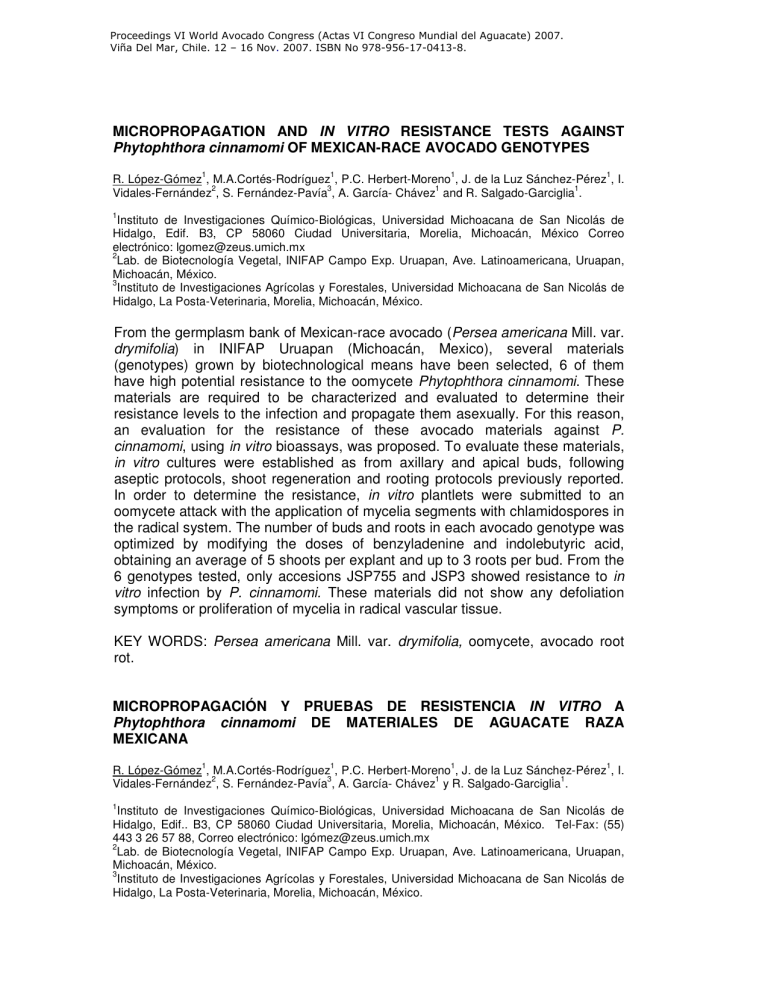
Proceedings VI World Avocado Congress (Actas VI Congreso Mundial del Aguacate) 2007. Viña Del Mar, Chile. 12 – 16 Nov. 2007. ISBN No 978-956-17-0413-8. MICROPROPAGATION AND IN VITRO RESISTANCE TESTS AGAINST Phytophthora cinnamomi OF MEXICAN-RACE AVOCADO GENOTYPES R. López-Gómez1, M.A.Cortés-Rodríguez1, P.C. Herbert-Moreno1, J. de la Luz Sánchez-Pérez1, I. 2 3 1 1 Vidales-Fernández , S. Fernández-Pavía , A. García- Chávez and R. Salgado-Garciglia . 1 Instituto de Investigaciones Químico-Biológicas, Universidad Michoacana de San Nicolás de Hidalgo, Edif. B3, CP 58060 Ciudad Universitaria, Morelia, Michoacán, México Correo electrónico: [email protected] 2 Lab. de Biotecnología Vegetal, INIFAP Campo Exp. Uruapan, Ave. Latinoamericana, Uruapan, Michoacán, México. 3 Instituto de Investigaciones Agrícolas y Forestales, Universidad Michoacana de San Nicolás de Hidalgo, La Posta-Veterinaria, Morelia, Michoacán, México. From the germplasm bank of Mexican-race avocado (Persea americana Mill. var. drymifolia) in INIFAP Uruapan (Michoacán, Mexico), several materials (genotypes) grown by biotechnological means have been selected, 6 of them have high potential resistance to the oomycete Phytophthora cinnamomi. These materials are required to be characterized and evaluated to determine their resistance levels to the infection and propagate them asexually. For this reason, an evaluation for the resistance of these avocado materials against P. cinnamomi, using in vitro bioassays, was proposed. To evaluate these materials, in vitro cultures were established as from axillary and apical buds, following aseptic protocols, shoot regeneration and rooting protocols previously reported. In order to determine the resistance, in vitro plantlets were submitted to an oomycete attack with the application of mycelia segments with chlamidospores in the radical system. The number of buds and roots in each avocado genotype was optimized by modifying the doses of benzyladenine and indolebutyric acid, obtaining an average of 5 shoots per explant and up to 3 roots per bud. From the 6 genotypes tested, only accesions JSP755 and JSP3 showed resistance to in vitro infection by P. cinnamomi. These materials did not show any defoliation symptoms or proliferation of mycelia in radical vascular tissue. KEY WORDS: Persea americana Mill. var. drymifolia, oomycete, avocado root rot. MICROPROPAGACIÓN Y PRUEBAS DE RESISTENCIA IN VITRO A Phytophthora cinnamomi DE MATERIALES DE AGUACATE RAZA MEXICANA 1 1 1 1 R. López-Gómez , M.A.Cortés-Rodríguez , P.C. Herbert-Moreno , J. de la Luz Sánchez-Pérez , I. 2 3 1 1 Vidales-Fernández , S. Fernández-Pavía , A. García- Chávez y R. Salgado-Garciglia . 1 Instituto de Investigaciones Químico-Biológicas, Universidad Michoacana de San Nicolás de Hidalgo, Edif.. B3, CP 58060 Ciudad Universitaria, Morelia, Michoacán, México. Tel-Fax: (55) 443 3 26 57 88, Correo electrónico: lgó[email protected] 2 Lab. de Biotecnología Vegetal, INIFAP Campo Exp. Uruapan, Ave. Latinoamericana, Uruapan, Michoacán, México. 3 Instituto de Investigaciones Agrícolas y Forestales, Universidad Michoacana de San Nicolás de Hidalgo, La Posta-Veterinaria, Morelia, Michoacán, México. Del banco de germoplasma de aguacate raza Mexicana (Persea americana Mill. var. drymifolia), en INIFAP Uruapan, se han seleccionado varios materiales (genotipos) mejorados por medios biotecnológicos, seis de ellos con supuesta resistencia al oomiceto Phytophthora cinnamomi que requieren ser caracterizados y evaluados para determinar sus niveles de resistencia y propagarlos asexualmente. Es por ello que en el presente trabajo se planteó evaluar la resistencia de estos materiales de aguacate criollo contra P. cinnamomi, mediante bioensayos in vitro. Para la evaluación de los materiales se establecieron cultivos in vitro a partir de la siembra de yemas axilares y apicales de varetas, siguiendo los protocolos de asepsia, regeneración de brotes y enraizado de éstos, reportados previamente. Para determinar la resistencia, las plántulas in vitro fueron sometidas al ataque del oomiceto, con la aplicación de segmentos de micelio con clamidosporas en el sistema radical. El número de brotes y de raíces en cada genotipo de aguacate fue optimizado por modificación en las dosis de benciladenina y ácido indolbutírico, consiguiendo 5 brotes/explante en promedio para cada material y hasta tres raíces por brote. De los 6 materiales probados, solamente las accesiones JSP755 y JSP3 mostraron resistencia a la infección in vitro por P. cinnamomi, no detectando síntomas de caída de hojas (defoliación) ni proliferación de micelio en tejido vascular radical, lo cual se observó en los otros 4 materiales. Palabras clave: Persea americana Mill. var. drymifolia, oomiceto, tristeza del aguacatero. 1 Introduction The avocado (Persea americana Mill.) is at the present time one of the most important agronomical cultures in Mexico, not only by the amount of tons produced, but also because it is a plant culture that generates thousands of direct and indirect employments and allows a high currency entrance by the export of its fruit. A commercial tree of avocado is made up of two vegetal materials, one called rootstock on which is grafted the other called variety (var.) or cultivar (cv.). This way, the producer confront two kinds of different problems when of diseases problems it is, that affect single rootstock and other that only affect the grafted variety. With the intention of avoiding the loss of trees in avocado orchards, the developed technologies have focused to the homogenous propagation of the materials, to their conservation (in situ) and with respect to the traditional genetic improvement, they have looked for firstly the way to identify materials with important breeding characteristics, to use them as rootstocks of commercial varieties of avocado. The Mexican race avocado materials of any vegetal species are source of genetic wealth for the study, isolation and identification of useful genes for the generation of new varieties. The avocado presents severe diseases that in extreme cases cause the death of the tree and in general, a diminution in the production that varies from the 10 to 40%, and the reduction in the fruit quality between 15 and 30%. The avocado root rot caused by Phytophthora cinnamomi Rands is one of the most destructive diseases in the avocado orchards anywhere in the world and has been the economically factor that limits the production in countries such as Australia, Mexico, South Africa and the EUA, and other seventy countries (Sanchez-Perez, 2001). Due to the existence of a Mexican race avocado germoplasm bank, in INIFAP Uruapan, and to that several resistant materials are improved by biotechnological means, 6 of them have been selected with supposed resistance to the oomycete P. cinnamomi. They require to be characterized and to be evaluated, to select the resistant ones and to determine its levels of resistance. It is for that reason that in the present work considered to evaluate the resistance of these materials of Mexican race avocado against the oomycete P. cinnamomi. The evaluation of the materials was made with plantlets regenerated in vitro by the culture of axillary and apical buds of the plants in study, for which the conditions of micropropagation were established. The plantlets were put under the attack of the oomycete, with the application of segments of mycelium with chlamydospores in the radical system to determine resistance, selecting one material resistant to the attack of P. cinnamomi. This one do not show the visual symptoms of root rot and proliferation of mycelium in tissue radical. 2 Materials and Methods 2.1 P. cinnamomi was isolated from rot roots of Mexican race avocado tree it was grafted with Hass cultivar showed “sad” symptoms localized in commercial orchard of avocado region of Uruapan, Michoacán, México. The isolate was characterized and identified with taxonomic keys. The Mexican races of avocado JSP064, JSP755 y JSP3 belongs to germoplasm bank in INIFAP-Uruapan, Michoacán, México. The resistant materials of avocado UV31,UV62 and UV78 was selected with supposed potential resistant to P. cinnamomi in previous works and they are growing under in vitro conditions (Hernández-García, et al., 2005). 2.2 Cultures in vitro.- The establishment of cultures in vitro of the Mexican races of avocado JSP064, JSP755 and JSP3 was carry out by asepsia method of Vidales (2002). The method consists in cultivate buds in MS nutritive medium (Murashigue and Skoog, 1962), with addition of 0.3 mg/l of BA (benzyladenine), the buds obtained after 45 days was cultived in MS medium with ABA (0, 0.5, 1.0, 2.0, and 2.5) mg/l and IBA ( indolebutyric acid) (0.1, 0.2 and 0.5) mg/l .These doses were supplied for to obtain clonal multiplication of each resistant material of avocado. These materials were cultived in MS medium with 0.4 mg/l of IBA for to obtain roots. The cultures were maintained 25º C and 16 h light (36 mol m-2 s-1). In this work were obtained 10 seedless for each avocado material. 2.3 Inoculation in vitro essays.- The seedless were maintained under culture in vitro conditions (90 days age) each seedless was inoculated with 10 ml of mycelium (1 x 103 clamydospores/ml) suspension. The suspensions were obtained of mycelium cultures in clarified PD-V8 liquid medium by 24 h under asepsia conditions. The inoculated seedless were placed on sterile filter paper for eliminate water excess and they were cultivated immediately in vitro in water-agar medium (6 g/l agar) by 8 days 25º C (36 mol m-2 s-1. Control plants were additioned with 10 ml of sterile water. The experiment was conduced with 6 repetitions for each avocado material. 2.4 Symptoms detection.- The inoculation effect was evaluated by the proportion of rot roots, disease symptoms (shrivelless, clorosis and partial or total of leaves rot) furthermore death rate. The treatments were distributed in random form with 6 repetitions and each seedless was considerate like experimental unit. 3 Results and Discussion Buds proliferation was optimized for each materials of mexican criollo avocado. We obtained until five buds by explant. Plant materials respondes differentially to MS medium; JSP064 and JSP3 responded with high buds in MS medium adicioned with BA 2.5 mg/L and AIB 0.1 mg/L, JSP755 MS with BA 2mg/L and AIB 0.2 mg/L, UV31, UV62 and UV78 MS with BA 1mg/L and AIB 0.1 mg/L. Bud proliferation start at 30 days and the maximal production was obtained at 90 days. These observations coincide with the dates publish previously by Vidales (2000). All the buds produced roots (until 3 roots /bud) in MS medium with AIB 0.4mg/L, attain with this in vitro plants formation of each material. Plantlets 90 days age with 5 cm high, two to four leafs and three roots were expoused to a clamydospores suspension of P. cinnamomi. The symtoms of the disease were observed at day 8 in sensible materials. The JSP755 and JSP3 did not present the disease symptoms even though there was mycelia proliferation in the culture medium. These plantlets were soil transplanted at day 10 after the infection and during the acclimation (45 days in humid camera) process they did not present any disease symtom by P. cinnamomi. All the plantlets of JSP064, UV31, UV62 and UV78 materials were die after 15 days of the clamydospores inoculation. The main disease symptoms were yellowish, epinasty and follow of the laefs and rot root. We observed the rot roots at optic microscopy (20X) and all of them showed mycelia proliferation. Avocado plantlets grown under the inoculation medium (agar-water) without clamydomoes inoculum, showed an average of 10% of rot roots, and 12.5 % for the P. cinnamomi attak resistant materials. This phenomenon coul be explained by the partial anoxy of the plantlets. 4 Conclusion In this work we shown that the in vitro infection of avocado platlets were efficient in all the evaluated parameters. The plantlets were infection suceptible to the oomycete P. ciinamomi. We observed the mycelia proliferation in the roots of the susceptible materials. Two avocado criollo materials were resisten to the disease (JSP755 and JSP3). These materials were grown actually under greenhouse for future resistant evaluations to P. ciinamomi. The in vitro selection selction coul be an alternative method for genetic improve of avocado. La inoculación de las plantas in vitro fue eficiente en todos los parámetros evaluados, sobre todo en las susceptibles al oomiceto, debido a la presencia de Phytophthora cinnamomi en las raíces, lo cual desencadenó la enfermedad. Pero también para poder caracterizar la resistencia de materiales como ocurrió para las plántulas de las accesiones JSP755 y JSP3. Las plántulas de estos materiales se mantienen bajo cultivo en invernadero para realizar las pruebas de resistencia bajo cultivo en suelo y comprobar la resistencia. 5 References Hernández-García A., Vidales-Fernández I., López-Gómez R. y SalgadoGarciglia R. 2006 Mutagénesis in vitro en aguacate criollo raza Mexicana para selección de genotipos resistentes a Phytophthora cinnamomi Rands. 1ª. Reunión Nacional de Innovación Agrícola y Forestal. 4-8 Sept., Mérida, Yucatán, México. Murashige T. y Skoog F. 1962. A revised medium for rapid growth and bioassays with tobacco tissue culture. Physiol Plant. 15: 443-497. Sánchez-Pérez J. de la L. 2001. Tecnología para la producción de aguacate en México. INIFAP, CIRPAC, C. E. Uruapan. Libro Técnico Num. 1. Michoacán, México. Vidales F. I. 2002. Efecto de los reguladores de crecimiento para la regeneración in vitro de aguacate (Persea americana Mill.): Embriogénesis somática y organogénesis. Tesis Doctoral, Universidad de Colima. 115p.
